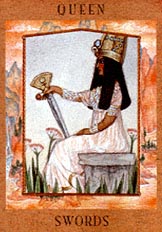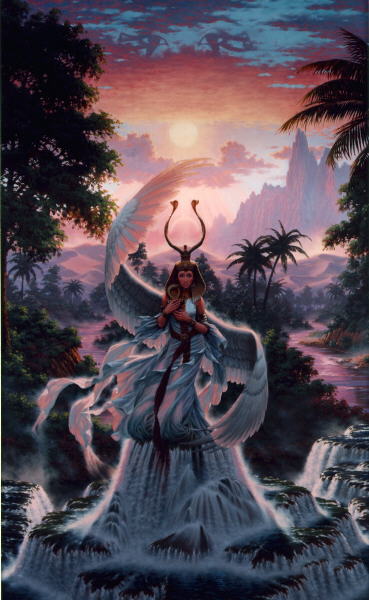
| Amenti, Lady at the Gates | Ammit, Devourer of Souls | Bast, Sacred Cat |
| Hathor, Cow Mother | Isis, Lady of Life | Ma'at, Cosmic Balance |
| Neith, Lady Supreme | Nekhbet, Lady Vulture | Nephthys, Lady of the House |
| Nut, Celestial Mistress | Qetesh, Sacred Love | Sekhmet, Fierce Lioness |
| Seshat, Mistress of Books | Taueret, Lady of Birth | Uadjet, Lady Cobra |
Egypt is an ancient land. It is one the most continuously inhabited regions of the world, with an archaeological record stretching back tens of thosuands of years. The Nile Valley was one of the first sites at which agriculture was discovered, some nine thousand years ago, along with Mesopotamia, the Indus Valley, the He Huang Valley and South-East Asia. (The peoples of Central America discovered the magic of seeds some centuries later.) The steady inundation and recession of the Nile played a dominant role in shaping Egyptian theology. The Nile was a clock; it set the pace of the seasons, of the agricultural cycle, and of the lives of the Egyptians themselves. It was their life-source, and it was benevolent. The River rarely failed the people; it flooded every year, depositing a layer of rich alluvial soil in which the Egyptians grew crops to feed themselves and their children and their cattle. As the River was steady and benevolent, so the Universe was largely perceived to be.
But there was another strain in Egyptian religion, another natural phenomenon which influenced theological development: the sharp contrast between the green of the River Valley and the red of the desert, the black and the brown, life and death. OUT THERE, in the desert, was death, heat, dryness, chaos, destruction. HERE, in the Valley, was life, coolness, green, moisture, order, construction. OUT THERE lived the demons of chaos and other elements of disorder. HERE lived the Gods and Goddesses of order. This contrast, this balance, was recognized as being precarious. The River might fail to flood, and occasionally did; then the green died and the desert crept closer. This balance was represented by a feather standing on end, and the Balance itself--natural, political, cosmological--was called Ma'at. Every Egyptian, but most especially the Pharaoh, was responsible for maintaiing the Balance, the Order which was Ma'at.
Ma'at has caused some problems for Egyptologists, for there is also a Goddess Who bears that name. Many are uncertain whether to consider Ma'at a concept, and the Goddess a personification of that concept, or whether Ma'at IS an actual, autonomous Deity. In the minds of the ancient Egyptians, there likely would have been no such distinction.
Long considered polytheists, Egyptologists have recently speculated that in fact the Egyptian religion was one which centered around a single, great universal life force, expressed in the form of multiple Deities. To the ancient Egyptians, the life force was not contained within human form alone. Rather, it was manifest in all forms, in all creatures, Deities, humans, animals and plants. It appears that they believed in a Web of Life, much as many Native Americans and Africans did and still do. Because of this interconnectedness, Deities were presented in andromorphic, gynomorphic and zoomorphic form: Osiris was a human male, while Isis could be a human woman, a woman with wings, a woman with a cow's head, or a cow herself. Deities occasionally appeared in plant form: a few images have been found of Osiris as the green, growing grain, while other paintings depict a woman in the branches of a tree dispensing the Waters of Life. Because of the perceived interconnectedness of life, the multifaceted nature of existence, Egyptian Deities rarely fit into neat categories (eg Goddess of the Sun, God of the Moon); rather, They often shared attributes, responsibilities, and even spouses and children.
Over the course of Egypt's three thousand year existence, Gods and Goddesses were born and died, changed Patronage and Matronage, and were absorbed into other Deities. New Gods and Goddesses were added from the pantheons of Libya, Nubia, and Palestine as trade and invasion brought foreign ideas and foreign peoples to the Land of the Nile. Egyptian Deities were exported to the Near East, Greece, Rome, then throughout the ancient world. They changed in response to the needs of Their new faithful, and often returned to Egypt, changed.
Over the course of some three thousand years, Egypt flourished under the rule of native Pharaohs, Assyrians, Nubians, Greeks and Romans. Only in the fourth century of the common era, under the aegis of Christian Byzantium, were the temples of the Goddesses and Gods closed. The invasion of Muslim Arabs in the seventh century destroyed or drove the few remaining faithful underground. The death of the Old Religion was a long and painful struggle. Comprehension of Egyptian hieroglyphic script was lost until the nineteenth century. Only then were native myths of Gods and Goddesses, unfiltered by the cultural bias and perceptions of Greeks and Romans, revealed. Only then were centuries of sand brushed away and the temples uncovered.
Back to Introduction
Back to Egyptian Goddesses
Back to Goddesses
Amenti, Lady at the Gates
 |
This Goddess of the Underworld was responsible for greeting the dead on their arrival in the West. As is often the case in Egyptian religion, Amenti's place was by no means permanent: other tales say Nut, Hathor, Neith or Ma'at greeted the dead. |
QUEEN OF SWORDS from ART
AND WORDS ©Kris Waldherr
Back to Egyptian Goddesses
Ammit, Devourer of Souls
| Ancient Egyptians had no conception of Hell or place of punishment; if one died with a soul weighed heavy with sin, the soul was destroyed, devoured by the monster Ammit. |
Back to Egyptian Goddesses
Bast, Sacred Cat
 |
Bast ( Bastet, Bastis, Bubastis, Pacht, Ubast) is a name well-known in the West. Family pets so named are not uncommon. Cats, as manifestations of Deity, were sacred; cemeteries of mummified felines have been unearthed by archaeologists. Bast was the daughter and/or wife of Ra, the God of the Sun. |
BAST ©JBL
Back to Egyptian Goddesses
Hathor, Lady Mother
| Hathor is generally presented as a Cow Goddess and Mother Goddess. She is a complex Deity, who is Matron of Love, yet also has a destructive element to Her nature. Some versions of the Egyptian creation myth identify Her as the Primal Creatrix. |
Back to Egyptian Goddesses
Isis, Lady of Life

|
Isis is the most well-known Egyptian Deity. Her worship flourished in Egypt for all of its three thousand years. Her faith eventually spread throughout the Near East and Mediterranean; the roads and ships of the Roman Empire carried Isis to ancient France, Germany and Britain.The image is an oil painting by Jonathon Earl Bowser, entitled ISIS: CHILDREN OF EARTH AND SKY. |
Back to Egyptian Goddesses
Ma'at, Cosmic Balance
| There is much debate among Egyptologists as to whether Ma'at is an "actual" Goddess or only the personification of a concept. Evidence weighs heavily on both sides. Many Egyptian temples show Her in human form. Yet cosmic balance, right order, natural law, was very much the idea at the heart of Egyptian civilization. |
Back to Egyptian Goddesses
Neith, Lady Supreme
| Neith is a perfect example of the evolving, syncretistic nature of Egyptian religion. She appears in both bovine and human form and Her titles are almost endless. The rational Greeks, attempting to quantify and contain Her unlimited Divine Essence, equated Her with their Goddess of War and Handicrafts and Civilization, Athena (see Minerva, Graeco-Roman Goddesses). |
Back to Egyptian Goddesses
Nekhbet, Lady Vulture
| Nekhbet is a very ancient Goddess of Upper (southern) Egypt. In some cosmogonies, She is the Creatrix. She is rarely represented in human form. |
Back to Egyptian Goddesses
Nephthys, Lady of the House
| Nephthys (or Nebthet) is generally interpreted by Egyptologists as the Dark Twin of Isis. They are sisters married to Their own brothers. Isis, Osiris, Nephthys and Set are the children of Nut (profiled below) and Geb, the Earth. |
Back to Egyptian Goddesses
Nut, Celestial Mistress
| Nut is the Mother of four of the primary Deities of the Egyptian pantheon: Isis, Osiris, Nephthys and Set. Her body is the Sky, Her husband the Earth. |
Back to Egyptian Goddesses
Qetesh, Sacred Love
| Her name, meaning "Holy One," is usually mistranslated as "Sacred Prostitute." She came to Egypt from the Near East. |
Back to Egyptian Goddesses
Sekhmet, Fierce Lioness
| Sekhmet (Sakhmis, Sekhet, Ubastet), is often confused or combined with Bast. Sometimes She is another form of Bast, sometimes another form of Hathor, sometimes an autonomous Goddess. |
Back to Egyptian Goddesses
Seshat, Mistress of Books
| In very ancient Egypt, priestess and scribe were often one and the same. Seshat's Divine position, and the earthly position of Her priestesses, were eventually taken over by Thoth and His priests. |
Back to Egyptian Goddesses
Taueret, Lady of Birth
| While Her name is not often recognized, Her manifestation in the form of a hippopotamus often is. She is primarily a Goddess of Midwives and Birth. |
Back to Egyptian Goddesses
Uadjet, Lady Cobra
| Uadjet is an extremely ancient Goddess of Lower (northern) Egypt. She is often paired with Nekhbet, and is personified by the uraeus, the cobra on the Pharaoh's crown. She is sometimes called Buto. |
Back to Egyptian Goddesses
Back to Introduction
Back to Eastern European Goddesses
Back to Goddesses